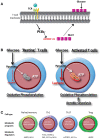Glucose metabolism regulates T cell activation, differentiation, and functions
- PMID: 25657648
- PMCID: PMC4302982
- DOI: 10.3389/fimmu.2015.00001
Glucose metabolism regulates T cell activation, differentiation, and functions
Abstract
The adaptive immune system is equipped to eliminate both tumors and pathogenic microorganisms. It requires a series of complex and coordinated signals to drive the activation, proliferation, and differentiation of appropriate T cell subsets. It is now established that changes in cellular activation are coupled to profound changes in cellular metabolism. In addition, emerging evidence now suggest that specific metabolic alterations associated with distinct T cell subsets may be ancillary to their differentiation and influential in their immune functions. The "Warburg effect" originally used to describe a phenomenon in which most cancer cells relied on aerobic glycolysis for their growth is a key process that sustain T cell activation and differentiation. Here, we review how different aspects of metabolism in T cells influence their functions, focusing on the emerging role of key regulators of glucose metabolism such as HIF-1α. A thorough understanding of the role of metabolism in T cell function could provide insights into mechanisms involved in inflammatory-mediated conditions, with the potential for developing novel therapeutic approaches to treat these diseases.
Keywords: HIF-1α; HIV; PI3K; glucose transporter 1; immune activation; inflammation; mTOR; metabolism.
Figures

References
Publication types
LinkOut - more resources
Full Text Sources
Other Literature Sources
Miscellaneous

